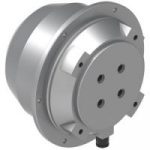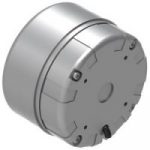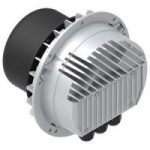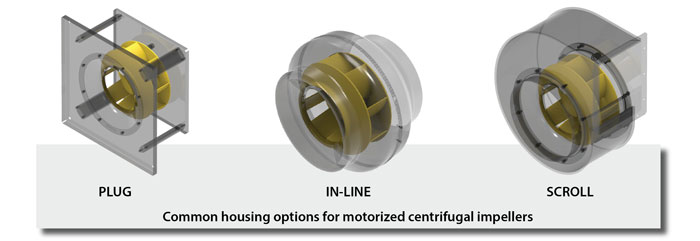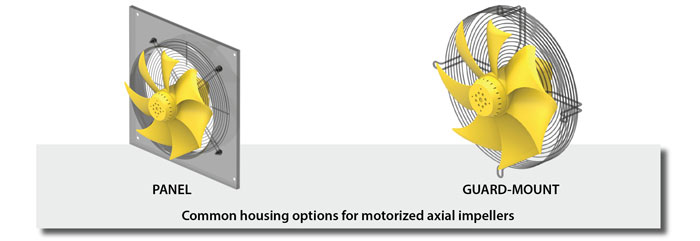 A motorized impeller comprises a fan impeller that is fixed to the rotor of an external rotor motor, eliminating the need for an output shaft and resulting in lower bearing loads and vibration-free operation.
A motorized impeller comprises a fan impeller that is fixed to the rotor of an external rotor motor, eliminating the need for an output shaft and resulting in lower bearing loads and vibration-free operation.
Since the motor and impeller are located directly in the air stream, the impeller also acts as a rotating heat sink, allowing for excellent heat dissipation and efficient motor cooling. This unique coupling of motor and impeller drastically reduces space requirements, allowing for easy installation and making motorized impellers perfectly suited to applications where space is limited.
_______________________________________________________
MOTOR DESIGN
Internal vs. External Rotor
Motors come in a wide range of shapes and sizes, with the conventional style being the internal rotor configuration.
Conventional internal rotor motors are designed with the stator (stationary component) fixed to the motor housing. The rotor (rotating component) is located inside the stator and transmits torque through the output shaft. A fan impeller is typically attached to the rotating shaft.
External rotor motors essentially have the opposite orientation, with the rotor rotating on the outside of the stator. This eliminates the need for an output shaft and greatly reduces the overall footprint of the motor and impeller assembly. A fan impeller can be attached directly to the external rotor, effectively creating a motorized impeller.
Operating Speeds
Conventional internal rotor motors are typically governed by a series of incremental power levels and standard speed ratings (i.e. synchronous speeds).
In comparison, the external rotor motors used in motorized impellers are designed to suit the impeller they are coupled with. This enables them to fall anywhere along the full range of available power and speed ratings, while allowing them to be more efficient by precisely matching the performance demands. In general, they can range anywhere from 25 W up to 7,000 W, and from 1,000 rpm up to 4,000 rpm. Depending on the type of power supply that the motor is designed to accept, the speed of an external rotor motor can be controlled in a variety of ways.
|
AC External Rotor Motors
|
|
DC External Rotor Motors
|
|
EC External Rotor Motors
EC motorized impellers can typically allow for closed loop control of temperature, pressure, and other parameters when either a 1-10 VDC or PWM speed control signal is coupled with an external sensor. Constant pressure control is particularly useful for ducted applications, while constant airflow control is more suited for filtered applications. Alternatively, a potentiometer can be connected to provide a manual form of variable speed control. |
_____________________________________________________________________________
IMPELLER DESIGN
Aside from motor options, motorized impellers are also available with different types of impellers. The two most common types of fan impellers are centrifugal and axial.
Centrifugal
Most centrifugal motorized impellers use backward curved (BC) blades because they generate significant static pressure, operate silently, and provide the highest efficiency of all centrifugal fan designs. Airfoil designs (BCA blades) can deliver even higher performance. In order to achieve optimal performance, inlet cones should be used with centrifugal impellers. Depending on the application, a motorized centrifugal impeller may be pre-installed in a fan housing.
Axial
Axial motorized impellers are typically used to move high volumes of air at relatively low static pressure. For this reason, they are primarily used in non-ducted systems that require high airflow rates. Highest efficiency is obtained when using airfoil blades in these systems. Axial motorized impellers are often used for supply or exhaust applications, and they can also be pre-installed in a fan housing.
_____________________________________________________________________________
INSTALLATION TYPE
The space-saving design of motorized impellers allows them to fit into smaller enclosures, making them especially attractive for applications with tight space constraints. Figure 1 below displays some typical installation arrangements for motorized centrifugal impellers.
_____________________________________________________________________________
APPLICATIONS FOR MOTORIZED IMPELLERS
There are a lot of choices when it comes to selecting a motorized impeller. Axial or centrifugal designs can be provided with or without a housing, and with a range of AC, DC, and EC motors. This variety ensures that most demands can be met, while making it difficult to determine which option is the best solution. By evaluating the requirements of a given application, the appropriate fan must be determined on a case-by-case basis. Some examples of applications for motorized impellers are shown in Figure 2.
_____________________________________________________________________________
WHY CHOOSE A MOTORIZED IMPELLER?
Motorized impellers are used in a wide range of industries. These precision-manufactured and finely tuned devices provide a range of benefits including extended service life, maintenance-free operation, along with low sound and vibration. To simplify matters even further, motorized impellers can be provided in a variety of pre-assembled housings, thereby reducing installation and assembly time.
An incredibly small footprint makes motorized impellers especially attractive for applications with tight space constraints. They are flexible enough to suit most requirements, while frequently operating at higher efficiencies than conventional fans.
These distinct advantages make motorized impellers the preferred fan choice.
Download a PDF copy of Motorized Impellers today!


